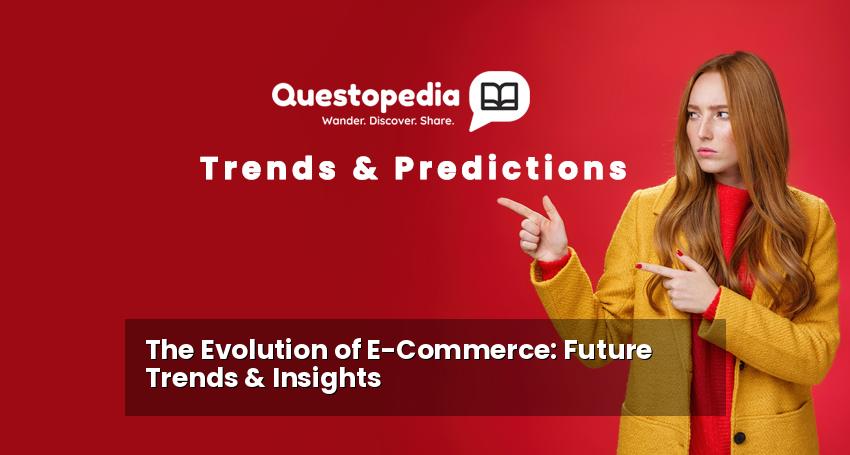The Evolution of E-Commerce: Future Trends & Insights
E-commerce has revolutionized the way we shop, transforming from a nascent online marketplace to a global powerhouse in just a few decades. From the first online transaction to today’s sophisticated platforms, the journey of e-commerce has been nothing short of remarkable. This article delves into the evolution of e-commerce, highlighting key milestones and exploring the future trends that will shape the industry in the years to come. Let’s embark on this journey to understand where we’ve been, where we are, and where e-commerce is headed.
A Brief History of E-Commerce: From Banners to Billions
The seeds of e-commerce were sown in the 1970s with Electronic Data Interchange (EDI), which allowed businesses to exchange information electronically. However, the real breakthrough came with the advent of the World Wide Web in the 1990s. The first secure online transaction took place in 1994, marking a pivotal moment for the industry. Early e-commerce platforms were rudimentary, often consisting of simple websites with static product listings and limited functionality. Amazon and eBay, established in the mid-1990s, were among the first to capitalize on the potential of the internet, paving the way for the e-commerce boom we see today. Initial marketing was often limited to banner ads and basic email campaigns. The focus was on simply establishing a presence online. For more historical context, resources like Shopify’s blog on the history of e-commerce can be helpful.
The Rise of Mobile Commerce (M-Commerce)
The introduction of smartphones and tablets marked another turning point in the evolution of e-commerce. Mobile commerce (M-commerce) exploded in popularity, allowing consumers to shop anytime, anywhere. Responsive website design became crucial, and businesses had to optimize their platforms for mobile viewing. Mobile apps emerged as a powerful tool for customer engagement, offering personalized experiences and streamlined purchasing processes. Push notifications, location-based services, and mobile payment options further enhanced the convenience of M-commerce, driving significant growth in online sales. According to Statista, M-commerce continues to experience robust growth, accounting for a significant portion of total e-commerce revenue. This shift necessitated businesses adapting their strategy, and investing in more mobile responsive layouts.
The Impact of Social Commerce
Social media platforms have become integral to the e-commerce ecosystem. Social commerce, the practice of selling products directly through social media channels, has gained immense traction. Platforms like Facebook, Instagram, and Pinterest have integrated shopping features, allowing users to discover and purchase products without leaving their social feeds. Influencer marketing has also played a significant role in the growth of social commerce, with brands partnering with influencers to promote their products to a wider audience. The visual nature of social media makes it particularly well-suited for showcasing products and creating engaging shopping experiences. This also enables more targeted advertisement campaigns based on user’s demographics and interests.
Personalization: Tailoring the Shopping Experience
In today’s competitive e-commerce landscape, personalization is key to attracting and retaining customers. E-commerce platforms are leveraging data analytics and artificial intelligence (AI) to understand customer preferences and behavior. Personalized product recommendations, targeted marketing campaigns, and customized shopping experiences are becoming increasingly common. By delivering relevant content and offers, businesses can enhance customer satisfaction, increase sales, and build stronger relationships. Machine learning algorithms analyze past purchases, browsing history, and demographic information to create personalized experiences for each individual shopper. This is often achieved through improved recommendation engines on website and personalized email marketing campaigns.
Augmented Reality (AR) and Virtual Reality (VR) in E-Commerce
Augmented Reality (AR) and Virtual Reality (VR) are poised to revolutionize the way we shop online. AR allows customers to virtually “try on” clothes or “place” furniture in their homes before making a purchase, enhancing the shopping experience and reducing the likelihood of returns. VR offers immersive shopping experiences, allowing customers to explore virtual stores and interact with products in a realistic environment. While still in its early stages, the potential of AR and VR in e-commerce is enormous, particularly for industries like fashion, home decor, and automotive. This technology is bridging the gap between online and physical retail, offering benefits of both realms.
The Rise of Sustainable E-Commerce
As consumers become more environmentally conscious, sustainable e-commerce is gaining momentum. Brands are increasingly adopting eco-friendly practices, such as using sustainable packaging, offering carbon-neutral shipping options, and sourcing products ethically. Consumers are also actively seeking out businesses that prioritize sustainability. Transparency and traceability are becoming increasingly important, with consumers wanting to know the origins of the products they buy and the environmental impact of their purchases. This trend is not only ethical but can also become a differentiating factor that drives sales for businesses embracing it.
AI and Automation in E-Commerce
Artificial intelligence (AI) and automation are transforming various aspects of e-commerce, from customer service to inventory management. AI-powered chatbots are providing instant customer support, answering questions, and resolving issues efficiently. Automation is streamlining order processing, shipping, and returns, reducing costs and improving efficiency. AI is also being used to personalize product recommendations, detect fraud, and optimize pricing strategies. The increased use of AI contributes to a faster, more efficient, and customer-centric e-commerce experience. This often results in higher conversion rates and improved customer satisfaction. You can find information on AI and e-commerce on McKinsey’s website.
Future Trends in E-Commerce: What Lies Ahead?
Looking ahead, several key trends are expected to shape the future of e-commerce:
- Voice Commerce: Voice-activated assistants like Alexa and Google Assistant are enabling consumers to shop using their voice.
- Headless Commerce: Separating the front-end presentation layer from the back-end e-commerce platform allows for greater flexibility and customization.
- The Metaverse and E-Commerce: Integration of e-commerce experiences within virtual worlds, offering new ways for consumers to interact with brands and products.
- Hyper-Personalization: Going beyond basic personalization to create truly individualized shopping experiences based on deep customer insights.
- Decentralized E-Commerce: Utilizing blockchain technology to create more secure, transparent, and decentralized e-commerce platforms.
Conclusion
The evolution of e-commerce has been a journey of constant innovation and adaptation. From humble beginnings to today’s sophisticated platforms, e-commerce has transformed the way we shop. By understanding the past, analyzing the present, and anticipating the future trends, businesses can position themselves for success in the ever-evolving e-commerce landscape. Embracing new technologies, prioritizing customer experience, and adopting sustainable practices will be crucial for thriving in the years to come. Check out more articles on trends at Questopedia.






